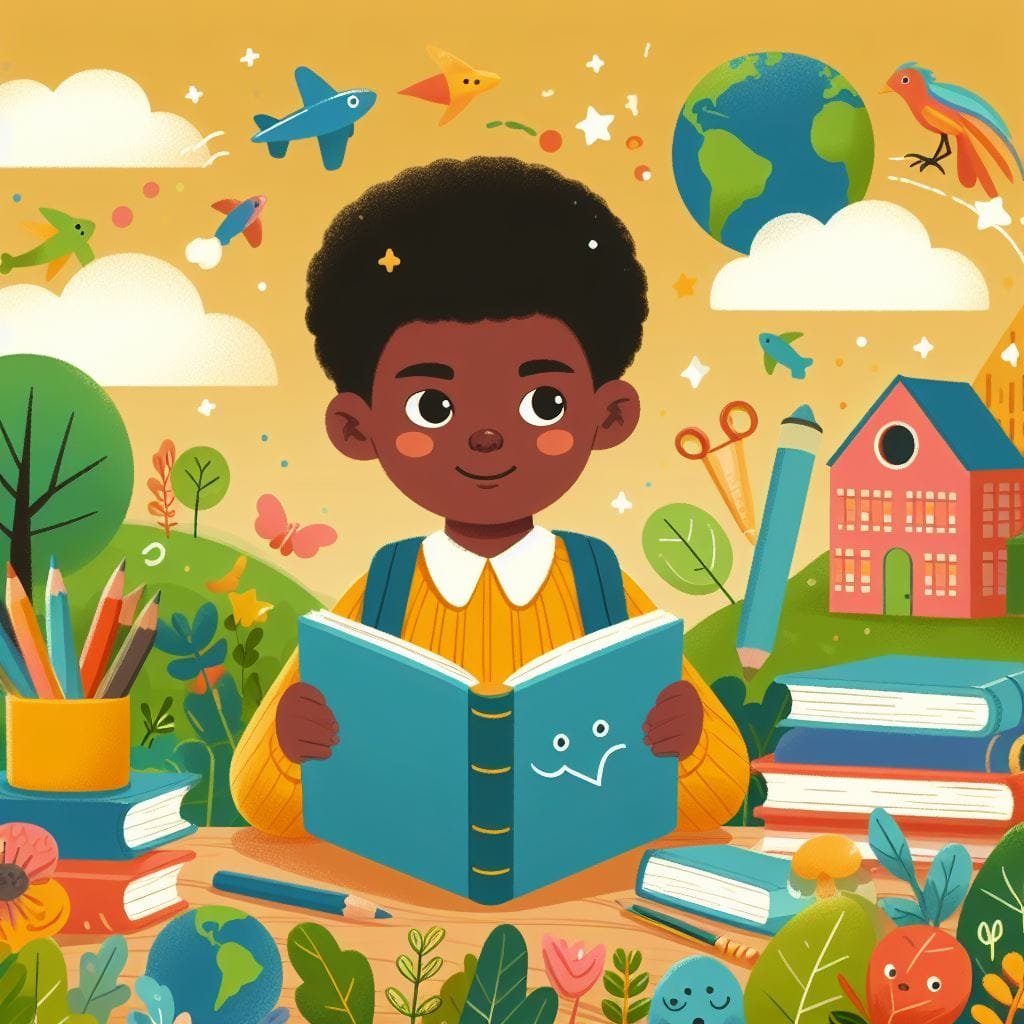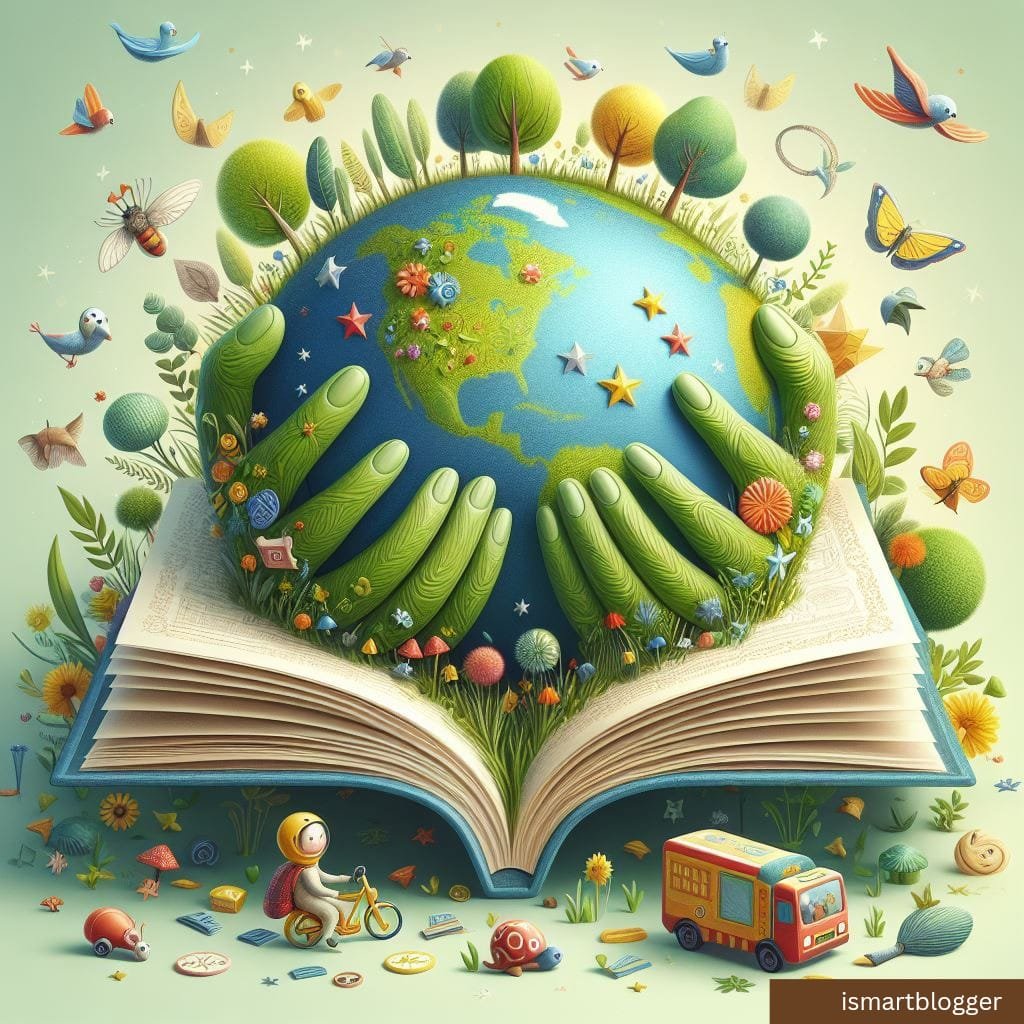Introduction
Children’s literature plays a pivotal role in shaping young minds and fostering a love for reading. In recent years, there has been a growing emphasis on promoting sustainability in all aspects of our lives, including children’s literature.
Sustainable children’s books are those that are created to minimize their environmental impact throughout their production and lifespan. These books are designed to educate and inspire young readers about topics such as environmental awareness, conservation, diversity, and inclusivity while incorporating eco-friendly practices.
Definition of sustainable children’s books
Sustainable children’s books go beyond mere content; they encompass a holistic approach to sustainability. They are made with environmentally responsible materials that minimize harm to the planet. The use of recycled paper and vegetable-based inks is one such example.
These materials reduce the demand for new resources, decrease energy consumption during production, and help mitigate waste generation from traditional book manufacturing processes. Furthermore, sustainable children’s books also consider the environmental impact of packaging choices.
Minimalist packaging designs using recyclable or biodegradable materials contribute to reducing waste that would otherwise end up in landfills or oceans. By adhering to these eco-friendly practices throughout the entire lifecycle of a book, publishers and authors can ensure that their works align with the principles of sustainability.

Importance of promoting sustainability in children’s literature
Promoting sustainability through children’s literature is crucial for several reasons. First and foremost, it lays the foundation for instilling environmental consciousness at an early age when young minds are receptive to learning about their impact on the planet. By integrating themes related to conservation and eco-awareness into storytelling, sustainable children’s books empower youngsters to become future stewards of our environment.
In addition to promoting environmental values, sustainable children’s books also play an essential role in fostering diversity and inclusivity. By featuring characters from diverse backgrounds, cultures, abilities, and genders, these books help children develop empathy, understanding, and respect for all individuals.
By joining forces and embracing sustainable practices, the children’s book industry has embraced a promising path to educating young readers about environmental and pragmatic consciousness e. This growing movement leaves us hopeful that future generations will be empowered to make a positive difference in creating a more sustainable world. quality.
Through engaging narratives that explore environmental challenges, these books inspire children to think creatively about potential solutions. By arming them with knowledge and encouraging them to take action toward sustainability, we empower future generations to become agents of positive change.
Overview of Sustainable Publishing Practices
Use of Eco-friendly Materials
Sustainable children’s books prioritize the use of eco-friendly materials throughout the production process. One essential aspect is the choice of paper and i.
Recycled paper, made from post-consumer waste, is a popular choice among environmentally conscious publishers. This reduces the demand for new paper production and helps save energy, water, and trees.
Additionally, vegetable-based inks are utilized instead of petroleum-based ones to minimize harmful chemical emissions during printing. These inks are derived from renewable resources like soy or linseed oil and offer a safer alternative for both human health and the environment.
Recycled Paper and Vegetable-based Inks
The shift towards using recycled paper has gained significant momentum in the sustainable publishing industry. Publishers carefully select papers with high post-consumer waste content to ensure minimal environmental impact.
These recycled papers maintain excellent print quality while reducing carbon emissions associated with virgin paper production. By opting for recycled materials, publishers actively contribute to reducing landfill waste and preserving natural resources.
Alongside recycled paper, sustainable children’s books employ vegetable-based inks which contain lower volatile organic compounds (VOCs) compared to traditional petroleum-based inks. VOCs release harmful chemicals into the atmosphere during printing processes contributing to air pollution.
Vegetable-based inks significantly reduce these emissions, making them a more eco-friendly choice. Furthermore, these natural inks can be easily removed during recycling processes without contaminating water sources or causing harm to ecosystems.
Forest Stewardship Council (FSC) Certified Paper
To further ensure sustainable practices within the publishing industry, many publishers opt for Forest Stewardship Council (FSC) certified paper for their children’s books. The FSC certification guarantees that the wood used comes from responsibly managed forests that adhere to strict ecological and social criteria.
By selecting an FSC-certified paper, publishers support the conservation of forests protection of wildlife habitats, and the rights of indigenous communities. This commitment helps create a more sustainable supply chain for children’s books and promotes responsible forestry practices worldwide.
Minimalist Packaging and Design
In addition to eco-friendly materials, sustainable children’s books embrace minimalist packaging and design principles. Excessive plastic packaging is avoided in favor of more environmentally friendly alternatives. Publishers strive to use minimal or entirely recyclable packaging materials to reduce waste generation and carbon emissions associated with production.
By adopting simple and streamlined designs, they minimize the use of resources while maintaining an aesthetically pleasing presentation. To further support sustainability efforts, publishers explore reusable or biodegradable packaging options.
This includes utilizing eco-friendly sleeve covers made from compostable materials or incorporating reusable fabric book bags instead of single-use plastic wrap. These innovative packaging solutions not only reduce environmental impact but also enhance the overall book-buying experience for both children and parents by providing practical yet sustainable options.
By implementing these sustainable publishing practices, the children’s book industry takes a proactive role in reducing its ecological footprint. From using recycled paper and vegetable-based inks to opting for FSC-certified materials and minimalist packaging designs, publishers demonstrate their commitment to creating a greener future for young readers while delivering high-quality literature that fosters environmental awareness.
Themes and Content in Sustainable Children’s Books
Environmental Awareness and Conservation Messages
In a world grappling with pressing environmental challenges, sustainable children’s books play a vital role in instilling environmental awareness and conservation messages from an early age. These stories serve as powerful tools to convey the importance of protecting nature and wildlife.
Through engaging narratives, children learn about the delicate balance of ecosystems, the value of biodiversity, and the consequences of human actions on the environment. These books often feature protagonists who embark on adventures that highlight environmental issues.
For example, a story might follow a young explorer who witnesses the devastating effects of deforestation or pollution on their surroundings. By showcasing these real-world problems through relatable characters, children develop empathy for nature and feel inspired to take action.
Teachings on Recycling, Reducing Waste, and Conserving Resources
Sustainable children’s books also incorporate teachings on recycling, reducing waste, and conserving resources into their narratives. Often presented in an accessible and age-appropriate manner, these concepts raise awareness about sustainable practices that can be implemented in everyday life. Through imaginative storytelling techniques such as colorful illustrations or interactive elements within the book itself, young readers are introduced to important lessons about waste management.
For instance, a story might follow a group of animal friends who learn how to recycle different materials or creatively repurpose items that would otherwise end up in landfills. By teaching children about these practices early on, they are empowered to become responsible stewards of the environment.
Diversity and Inclusivity Representation
Sustainable children’s books strive to promote diversity and inclusivity by featuring characters from various backgrounds, cultures abilities, and genders. By presenting diverse perspectives within narratives focused on sustainability themes, these books foster empathy, understanding, and respect for all individuals.
Representation matters greatly in children’s literature as it allows young readers to see themselves reflected in the stories they read. Sustainable children’s books aim to showcase protagonists from different ethnicities, cultures, and abilities, thereby celebrating the richness of human diversity.
Additionally, these stories often challenge traditional gender roles by presenting characters who defy stereotypes and embrace a wide range of interests and talents. Through diverse representation, sustainable children’s books inspire children to appreciate and respect others’ unique experiences while highlighting the shared responsibility for protecting the environment.
This inclusivity fosters an understanding that sustainability is a collective effort that transcends boundaries and requires collaboration across diverse communities. By integrating environmental awareness, teachings on sustainable practices, and inclusive representation into their narratives, sustainable children’s books have the power to shape young minds positively.
These books not only educate but also inspire action and empathy in children as they navigate their way toward becoming responsible citizens of the planet. In promoting these themes through engaging storytelling techniques, sustainable children’s books contribute significantly to building a future generation that values both environmental preservation and social equity.
Innovative Approaches to Sustainability in Children’s Books
Interactive elements promoting hands-on learning
Children are naturally curious and thrive on interactive experiences. Sustainable children’s books have embraced this aspect by incorporating interactive elements that promote hands-on learning.
One such example is the use of pop-up books with educational content on renewable energy sources. These captivating books use intricate paper engineering to bring concepts like solar power, wind energy, and hydroelectricity to life.
With each turn of the page, young readers witness the magic of renewable energy through moving parts and engaging visuals. This not only enhances their understanding of sustainable practices but also sparks their imagination and curiosity about finding innovative solutions for a greener future.
Another way sustainable children’s books encourage hands-on learning is through do-it-yourself (DIY) crafts using recycled materials included within the book. These crafts serve a dual purpose: they provide a fun activity for children and teach them about the importance of repurposing items to reduce waste.
The books often contain step-by-step instructions and materials needed to create various eco-friendly crafts like recycled paper art, upcycled planters, or even homemade compost bins. By actively involving children in these activities, they develop a deeper appreciation for sustainability while honing their creativity and problem-solving skills.
Digital integration for a greener reading experience
As technology continues to evolve, sustainable children’s books have embraced digital integration as an alternative option for a greener reading experience. E-books with interactive features have gained popularity as they offer an immersive way to teach environmental concepts while reducing the demand for physical resources. These e-books often include animations, sound effects, quizzes, and informative videos that enhance storytelling and engage young readers in an environmentally conscious manner.
Additionally, digital platforms allow easy updates and revisions to incorporate new knowledge or address emerging sustainability issues. Moreover, online platforms are fostering virtual storytelling sessions to reduce the carbon footprint associated with traditional book tours and author visits.
By leveraging video conferencing tools, authors and illustrators can connect with children worldwide, bringing their stories and sustainability messages directly into classrooms or homes. These virtual sessions not only reduce travel-related emissions but also provide a more inclusive experience, allowing children from different locations to participate simultaneously.
Through these digital initiatives, sustainable children’s books are reaching a wider audience while minimizing their environmental impact. Innovative approaches to sustainability in children’s books offer exciting opportunities for interactive learning and greener reading experiences.
Pop-up books with educational content on renewable energy engage young readers through captivating visuals and moving parts, while DIY crafts encourage hands-on creativity using recycled materials. Digital integration through e-books with interactive features provides an immersive learning experience while reducing the use of physical resources.
Additionally, online platforms that host virtual storytelling sessions enable global connections without the carbon footprint associated with traditional events. These innovative strategies further enhance the impact of sustainable children’s books in educating and inspiring young minds toward a more sustainable future.
Collaborations between Authors/Illustrators & Publishers/Printers
Partnerships that prioritize sustainable practices throughout the production process
In the realm of sustainable children’s books, collaborations between authors/illustrators and publishers/printers play a crucial role in promoting eco-conscious practices from inception to publication. These partnerships prioritize sustainability throughout the entire production process, ensuring that the end product is aligned with environmentally friendly principles. By working together, creators and publishing entities can adopt innovative strategies to minimize their ecological footprint.
Author-illustrator collaborations with eco-conscious publishers
One significant aspect of sustainable children’s books is the collaboration between authors/illustrators and eco-conscious publishers who share a commitment to environmental stewardship. Such partnerships allow for better integration of sustainability themes and messages within the content itself.
Eco-conscious publishers actively seek out authors and illustrators who are passionate about environmental issues—individuals who can effectively weave these concerns into engaging narratives or visually compelling illustrations. Through author-illustrator collaborations, sustainable children’s books become powerful tools for educating young readers about important ecological concepts while fostering their love for literature.
Printers using water-based coatings
Printers also play a vital role in promoting sustainability in children’s book production. An emerging trend in this industry involves the use of water-based coatings instead of traditional petroleum-based ones. Water-based coatings are not only more environmentally friendly but also offer several advantages over their counterparts.
These coatings emit fewer volatile organic compounds (VOCs), helping to reduce air pollution during printing processes. Additionally, they are easier to recycle than petroleum-based alternatives, further contributing to waste reduction efforts.
Conclusion
Collaborations between authors/illustrators and publishers/printers in the realm of sustainable children’s books demonstrate a collective commitment towards embracing eco-friendly practices throughout every stage of production. These partnerships prioritize sustainability by working with eco-conscious publishers, enabling the integration of environmental themes within captivating narratives and illustrations. Moreover, printers employing water-based coatings help minimize the ecological impact of printing processes while improving recyclability. By joining forces and embracing sustainable practices, the children’s book industry has embraced a promising path toward educating young readers about environmental consciousness engagingly and pragmatically. This growing movement leaves us hopeful that future generations will be empowered to make a positive difference in creating a more sustainable world.





